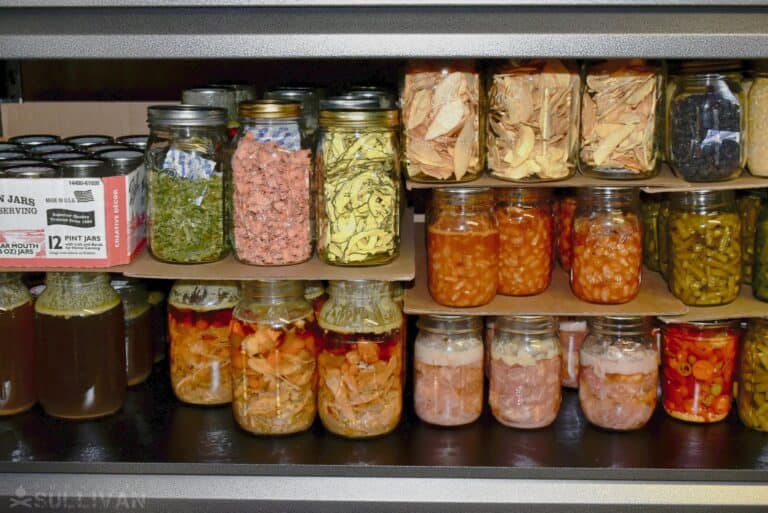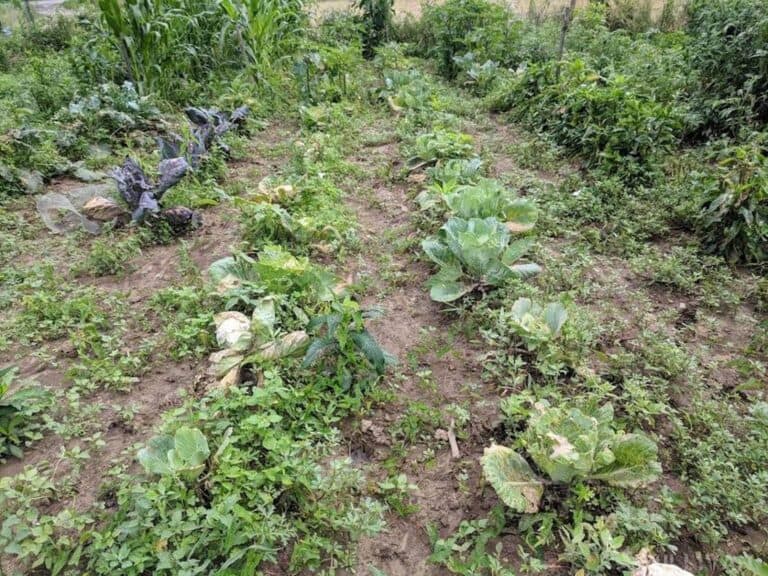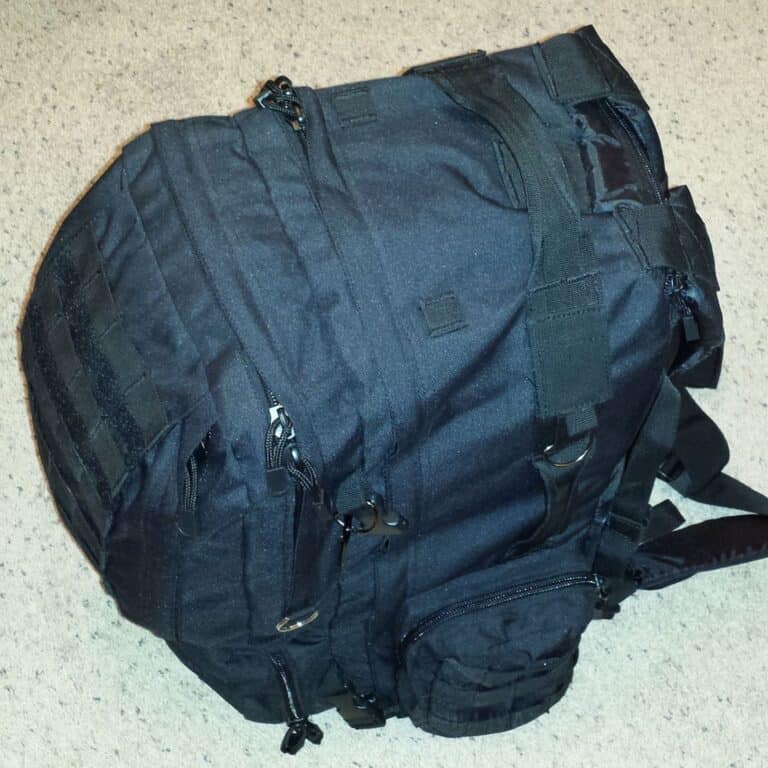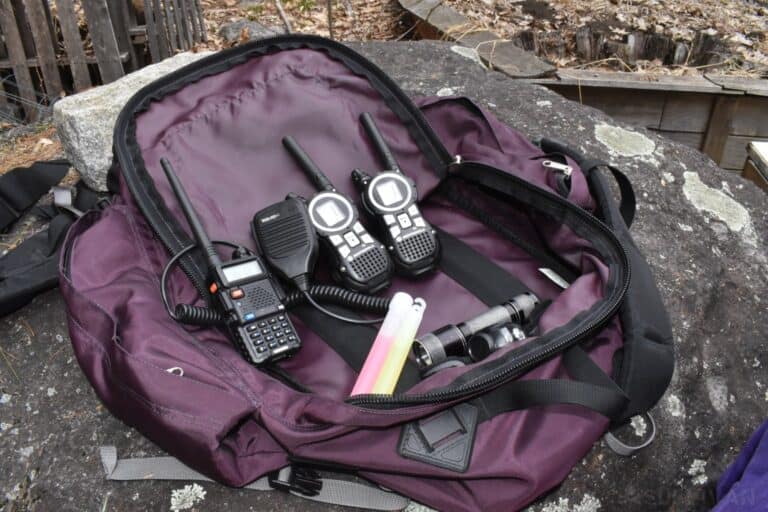Are you prepared for a SHTF event? If not, you need to start planning now. Trials and tribulations are the rule of human existence; prosperity and civilization is the exception.
Going along thinking that nothing bad could possibly happen is dangerously shortsighted.
A SHTF event is any catastrophic event that causes the breakdown of society. This could be a natural disaster, economic collapse, terrorist attack, or civil unrest.
This also means that the services we rely on to hold civilization together and the rule of law will also evaporate.
In times like that, only the hard, the strong, the prepared and the exceptionally lucky will survive.
If you are not prepared, your chances of survival are not good. In this article, we will discuss the basic steps you need to take to prepare for a SHTF event.

What are Some Common SHTF Events?
There are many potential SHTF events. Some of the more common ones include:
- A natural disaster such as a hurricane, tornado, tsunami, wildfire or earthquake
- A financial crisis that causes widespread economic collapse
- Civil unrest caused by political instability or social injustice
- A cyber-attack that cripples critical infrastructure
- A long term power outage
- An EMP
- The eruption of a supervolcano
All of these events could have dreadful consequences on society, even the globe.
The toll in lives, property and material can be huge, from the local level to the national level. How can anyone survive something like that? How can you prepare for it?
Understanding Your Specific Vulnerability to SHTF Events
No matter what kind of incident you are likely to be facing, you will generally prepare yourself to deal with it at some point in the future the same as you would any other indeterminate problem.
Understanding the Threat
The first step is to educate yourself about the specific threat. What are the chances of it happening? What would be the consequences if it did happen? How much time do you have to prepare?
Identifying Your Risks
Once you understand the threat, you need to identify your specific risks. What parts of the country or world are most vulnerable? What are your specific vulnerabilities?
How will the event hurt you? Is it directly dangerous, or is it mostly dangerous because of second- and third-order consequences? How quickly can it arrive or occur?
Responding Correctly and Quickly
The next step is to respond to the event. How you will respond, and how accurate your assessment of the event is, will likely dictate your outcome.
This includes both short-term and long-term plans. What do you need to do immediately?
What can you put off until later? How will you get information about the event as it unfolds to further refine your response? Who will you rely on for help?
Sustaining Survival Necessities
In the aftermath of the event getting back to “normal” might be days, weeks, months or even years away. You will need to take care of your self and your loved ones until that time.
This includes having and continuing to provide food and water, shelter, clothes, medical supplies, security and all the other necessities of life. How will you accomplish that in your area or elsewhere?
The Phases of SHTF Preparedness
Talking stock of your vulnerability to all manner of incidents, disasters and threats can make you feel dizzy and a little sick.
There is so, so much that can wrong, that can hurt you! How does one even begin after waking up to the idea that the world won’t always be just hunky-dory?
There is no one-size-fits-all answer to this, but it’s a good idea to start by dividing SHTF preparedness into three phases: Prepping for the Short Term, Medium Term, and Long Term.
Prepping for the Short Term means having supplies and plans in place to get you through up to two weeks without any outside help. This might include things like food, water, first aid supplies, and self-defense items.

cans of peanut butter on pantry shelvesPrepping for the Medium Term means having supplies and plans in place to get you through up to two months without any outside help.
This might include things like long term food storage, fuel storage, alternate sources of power, sanitation considerations, etc.
Prepping for the Long Term means having supplies and plans in place to get you through an indefinite period of time without any outside help.
This might include things like a sustainable food source, alternate shelter, self-defense strategies that don’t rely on society, etc.
The important thing is to start with the phase that most applies to your current situation and work your way up. Don’t try to do it all at once – that’s both impossible and unnecessary.
Just take it one step at a time and soon you’ll be prepared for anything! Remember: all you can do is what you can do with what you have.
Short Term Prepping: Security, Food and Water, Shelter
One of the most important aspects of short term prepping is providing for security, food and water, and shelter.
Security is physical protection form a specific threat, be it people, a natural disaster or a man-created event or accident.
You need to have enough food and water to last you for at least two weeks for obvious reasons. You need shelter to protect yourself from exposure to the elements, particularly the cold.
Security: In a SHTF scenario, there will be no police or military to protect you. You will need to be able to defend yourself, your family, and your property from looters and other criminals.
This means you will need weapons and training in how to use them. You should also have a plan for fortifying your home against intruders.
Food and water: One of the first things that will disappear in a SHTF scenario is food and water. You need to have enough stored up to last you and your family for at least a few weeks.
If possible, you should also have a way to purify water and grow your own food.
Shelter: In a SHTF scenario, your home may not be safe. You may need to bug out to a safe location or build a shelter to protect yourself from the elements.
Either way, you will need to have supplies on hand to keep yourself and your family safe and comfortable.
Medium Term Prepping: Food Storage, Fuel Storage, Alternate Power, Sanitation
Once you have your basic security, food and water, and shelter needs taken care of, you can start to focus on medium term prepping. This involves preparing for a longer-term event or scenario in which outside help is not available.
Food Storage: One of the most important things you can do in a medium term SHTF scenario is store up enough food to last you for at least two months.

Home (pressure) canned and dehydrated long term pantry meals and sides.You should also have a way to cook that food without relying on outside sources of power.
Fuel Storage: In a medium term SHTF scenario, fuel will be in high demand and may be difficult to come by. You need to have enough stored up to last you for at least two months.
Alternate Power: If the power goes out in a medium term SHTF scenario, you will be without light, heat, and refrigeration. You need to have a plan for generating your own power or accessing alternate sources of power.
Sanitation: In a medium term SHTF scenario, sanitation may become a problem. You need to have plans for dealing with garbage, wastewater, and vermin infestations.
Long Term Prepping: Sustainable food source, Alternate shelter, Group self-defense strategies
Once you have taken care of your basic security, food and water, and shelter needs, you can start to focus on long term prepping.
This involves preparing for a scenario in which outside help is not available and may never be available again.
Sustainable food source: In a long term SHTF scenario, you will need to find a way to sustain yourself without relying on outside sources of food.
This means growing your own food or stockpiling food that does not require refrigeration or special handling.
Alternate Shelter: If the power goes out in a long term SHTF scenario, you may not be able to stay in your home anymore.
You need to have plans for alternate shelter, whether that means building your own shelter or finding a safe place to stay.
Group self-defense strategies: In a long term SHTF scenario, you will need to be able to defend yourself and your group from outside threats.
This means having a plan for how to deal with looters, raiders, and other groups that may pose a threat.
No matter what kind of SHTF event you are preparing for and no matter how long it lasts, security, food and water, and shelter are the most important things you need to focus on.
The only question is how long the crisis will last: that’s how long you must supply your own!
Skills Will Keep You Alive
While having supplies is important, it’s not the only thing that will keep you alive in a SHTF scenario. Your skills and knowledge will also play a big role in your ability to survive.
There are plenty of real-life tales floating around of extraordinarily well-equipped people who were found dead with most of their supplies intact.
Many of them committed suicide. Why? They lacked the skills and experience that would produce real confidence in the face of the unknown and the terrifying.
You’ll need to be well-rounded, but not necessarily an expert, in many skills to consider yourself prepared for any SHTF event. These include, but are not limited to:
Firearms and self-defense
You don’t need to be a Navy SEAL, but you should know how to use and maintain firearms, as well as how to defend yourself in hand-to-hand combat.
As mentioned above, a breakdown of law and order combined with human desperation will set the stage for plenty of dangerous conflicts.
First-aid and medical
The only thing that won’t be in short supply during an SHTF event is injury and illness.
You should know how to treat common injuries and illnesses, as well as how to administer first-aid and basic trauma care alike.
Food preservation
Food is an incredibly precious resources, and letting it go to waste during a crisis is a cardinal sin.

home canned food labeled with duct tapeYou should know how to can, dehydrate, and ferment food in order to maximize its shelf life and protect your investment.
Gardening
A garden, even a small one, is an excellent component in a long-term food sustainability plan, and can provide you and yours with nutritious, fresh foods year around with proper planning.

rows of cabbage in veggie gardenYou need to get started early and diligently maintain it if you want to reap the benefits, however.
Hunting and trapping
Animal protein is one of the best and most nutritious foods you can eat, but without your local grocery stocking cold cases full of it, you will be forced to find, catch and kill it yourself, and well as process the carcass.
You should know how to identify edible game, track animals, dispatch them effectively with a variety of weapons, and build traps.
Fishing
If you live near large bodies of water, fish can well prove to be a superior and easier source of protein compared to terrestrial land mammals.
You should know how to identify edible fish, catch them, clean and cook them.
Shelter construction
Shelter is always going to be high up on the list of survival necessities, and you must be able to accommodate in any environment using any materials at hand.
You should be able to build a basic shelter out of natural materials and scavenged man-made supplies alike.
Outdoor Survival skills
You should know how to find and purify water, start fires without matches, and navigate in the wilderness and in urban areas.
The more skills you have, the better off you will be in a SHTF scenario. But don’t worry if you’re not an expert in all of these areas.
Start learning now, and you’ll be much better prepared than someone who waits until the last minute.
In many cases an “expert generalist” or jack of all trades is better off and more adaptable than an overspecialized master of only one skill.
First-Aid and Medical Considerations
Among the most important skills and supplies you can amass are those concerning first aid and other medical care.
So much of our modern lives are made possible and so many once hideous diseases and injuries made survival only thanks to modern medical care.
In the middle of an SHTF event, the intricate web that forms higher level medical Care institutions will degrade, become overwhelmed or stop working entirely.
this means that you must become your own first responder, and at least passingly competent. in many cases you will be the only medical care provider that an injured or sick person has access to.
This is a weighty responsibility, but one you can meet with some study and practice.
At the very least you should know how to perform CPR and how to deal with common injuries like lacerations, burns, broken bones and so on.
A good book on first aid is “Where There Is No Doctor” by David Werner. It’s available for free online and covers a wide range of topics in first aid, from dealing with gunshot wounds to childbirth.
You should also stock supplies like bandages, antiseptics, painkillers, and other basic medicines. If possible, learn how to make your own tinctures, salves, and other preparations from medicinal plants.
This could come in very handy if commercial supplies run out or are unavailable. A good book on this subject is “The Herbal Medicine Maker’s Handbook” by James Green.
Bugging Out
You’ll hear the phrase bugging out referred to constantly in prepping circles. bugging out is basically an evacuation, only one where you aren’t necessarily following the rest of the sheep as they head towards promised rescue.
Looking out means you are heading for a place of your choosing, or at least one you have determined to be safer then where you are.
Bugging out is typically done when the situation is so bad where you are or is likely to become untenable that you decide to take your chances on the road or by foot.
To do this you’ll need two things. You’ll need to have a bug out bag, a large bit of luggage that will carry all the supplies you need, and you’ll need a predesignated bug out location or two.
Your bug out bag should be packed with enough supplies to last you at least 72 hours, and ideally more. water, food, shelter, clothing, tools and weapons are all going to be important. You’ll also need medical supplies as mentioned above.
You should have a few different options for where you will go in the event that you need to bug out.
This could be a cabin in the woods owned by a friend or relative, a piece of property you own yourself or even just an area you are familiar with that is remote and has good resources like water and game.
The key is to have a plan and to practice it so that if the time comes when you need to implement it, everything will happen as smoothly as possible.
Bug-Out Bags
Your bug out bag it can be thought of as your survival air tank for an SHTF situation. This is what you will grab and strap on or toss in the car when you are running out the door to avoid trouble.
Your bug out bag will carry shelter supplies, water, food, defensive gear, navigational aids and more.

a black bug out bag backpackSetting up a bug out bag, choosing a backpack, and packing one properly is an entire subject all on its own. But, here are a few tips to get you started.
Your bug out bag should be big enough to carry everything you need, but not too big or bulky that it becomes a pain to transport. It should also be comfortable enough to wear for extended periods of time.
You’ll want your bag to be as versatile as possible, able to handle different situations and environments. Think about packing supplies for different climates and terrains. Make sure you pack essential items like:
- Water, food and cookware
- Medical supplies (bandages, antiseptics)
- Tools and weapons
- Shelter (tarps, tents, hammocks)
- Firestarting materials
- Navigation aids (GPS, compass)
- Clothing and bedding
- Communication devices (radio, cell phone)
- Cash and bartering goods

communication devices inside bug out bag: a Baofeng HAM radio, walkie-talkies, flashlight and two chemlightsAnd don’t forget the most important item of all: your emergency contact info and route plan, stored in a safe place. While bugging out may seem like an extreme measure, it’s best to have a plan in place
Practice packing your bug out bag and test it out on short day hikes or overnight camping trips.
This will help you to identify any areas that need improvement and make sure you have everything you need in an emergency situation.
Bug-Out Locations
Your bug out location is where you are heading to when you flee your own home.
This could be the house of a friend or relative, a piece of property you own, public land or anyplace else where you think you’ll be safe from the current threat and also have access to everything you need in order to survive.
Choosing bug out locations is another intricate topic, and there are many variables.
Variables such as the threat or disaster that sent you fleeing in the first place which could affect your bug out location, the season, the accessibility of the location and more.
But, some tips to get you started include:
- Choosing a location that is familiar to you
- Considering multiple locations in case one is inaccessible
- Having a backup plan for your backup plan
- Selecting locations with ample resources like water, food and shelter
Avoid bug-out locations that are:
- Commonly traveled
- Crowded or well-known
- Difficult to get to
- Limited in resources
- Likely to be guarded or patrolled
- Inherently dangerous
Remember, your goal is to get to your bug out location safely and with as little hassle as possible. So plan ahead and be prepared.
When it comes down to it, bugging out is not a decision to be made lightly. But, if you find yourself in a situation where it is the best option, then being prepared will make all the difference. Hope for the best but plan for the worst.
Bugging out isn’t something most people want to think about, but it’s important to be prepared.
By having a bug out bag packed and ready to go, and by choosing safe bug out locations ahead of time, you’ll be able to rest easy knowing that you’re prepared for whatever comes your way.
Bugging In
Bugging in is the opposite of bugging out, a term used for staying put during a disaster or emergency situation.
This could be because bugging out is not an option, because the threat is too close to home or for any other number of reasons.
When you are able, bugging in is almost always a better, safer option than bugging out: you’ll have many more advantages!
When bugging in, it’s important to make sure your home is stocked with supplies and that you have a plan in place in case things go south. Some things to consider include:
- Food and water storage
- Medical supplies
- Defensive measures (weapons, security systems)
- Communication devices
- Sanitation and hygiene items
- Fuel and light sources
While bugging in is not as glamorous as bugging out, it’s the smarter option, and could very well save your life.
It’s also important to have a designated meeting spot for family members or loved ones in case of separation at the onset of the event.
By planning ahead and having a solid game plan, you can rest easy knowing that you’re prepared for any situation.
When disaster strikes, it’s important to have a plan. By having a bug out bag packed and ready to go, and by choosing safe bug out locations ahead of time, you’ll be able to rest easy knowing that you’re prepared for whatever comes your way.
Bugging in is also an important part of disaster planning: make sure your home is stocked with supplies and has defensive measures in place in case things go south. With a little preparation, you can feel confident that you are ready for anything.
Preparing for SHTF with Family
One of the most important simultaneously the most frightening things you’ll have to deal with in order to get prepared for an SHTF event is getting ready to survive with your family.
For most of us, our family members are the most precious things in our lives, and if you are reading this you have probably taken the ultimate responsibility for their safety.
This is the way things are, but that doesn’t mean it is not going to be far more complicated than if you were just worried about yourself.
Each of your family members, depending on their age, condition and other factors, will bring more or less to the table when it comes to the business of survival.
Some of them will be genuine assets where others will be a sort of precious cargo that must only be protected. Some family members, particularly infants and very small children, are extremely burdensome and vulnerable.
This means you must plan around family and other group factors from the get-go no matter what situation you might conceivably be facing. Is it just you and your partner?
So long as they are fit and healthy you’ll at least have one person that you can trust to help take care of business.
If you have three different children of three different ages some might be more capable than others. Very elderly parents or infirm family members with special needs and care requirements will further complicate matters.
When considering complicated family situations it is easy to say that you will always bug in or always bug out, but it isn’t that simple. It is difficult to predict the domino effect of second and third order factors.
When it comes to preparing for SHTF, it’s important to involve your family in the process. This way, everyone will be on the same page and know what to do in case of an emergency. Here are some tips on how to get started:
Talk to your family about what could happen in a SHTF scenario. Discuss different scenarios and come up with a plan for each one.
- Make sure everyone knows where the supplies are stored and how to access them.
- Practice using the supplies so that everyone is familiar with them.
- Have regular discussions about the plan so that everyone is up to date.
- Following these tips will help ensure that your family is prepared for SHTF.
Worst-Case Scenarios
Worst-case scenarios are exactly what they sound like. These are events were absolutely everything that could go wrong has gone wrong, or genuinely apocalyptic happenings with national or global consequences.
This could be as simple as the total or near total collapse of government and the rule of law in a civilized Nation or something as cataclysmic as a planet-wiping asteroid strike.
Think of these as hard mode for what is already an extremely difficult situation.
These are the things that you are unlikely to survive even in a best case example, and surviving the aftermath will be incredibly complicated and difficult.
Nonetheless, it can still be done if you prepare accordingly but you’re going to have to prepare hard.
If you’re caught in a worst case scenario, the first and most important thing is to stay calm. Panicking will only make things worse.
You need to think clearly if you want to survive. The next step is to assess the situation and figure out what you can do to improve it.
This may include finding adequate shelter under the circumstances, gathering food and water, or trying to establish precisely what is happening and what you can expect in a chaotic world.
Whatever you do, try not to take unnecessary risks; there will be plenty to go around!
Lastly, remember that hope is not lost. There is always a chance for survival no matter how bleak things seem. Stay strong and never give up hope.
Now You’re Ready to Survive
No one knows when or where the next SHTF event will take place. But by preparing for all possible scenarios, you can increase your chances of survival.
Focus on basic security, food and water, and shelter needs first, then start to focus on long term prepping.
This involves preparing for a scenario in which outside help is not available. This has been just a basic overview of preparing for a SHTF event.
For more detailed information, check out our other articles on the subject. And remember, it’s always better to be prepared than sorry.
The post How to Survive a SHTF Event appeared first on Survival Sullivan.
By: Tom Marlowe
Title: How to Survive a SHTF Event
Sourced From: www.survivalsullivan.com/how-to-survive-shtf/
Published Date: Thu, 24 Mar 2022 16:02:16 +0000
-------------------------------------------------------------------------
Did you miss our previous article...
https://outdoorsnewswire.com/survivalist/is-knocking-on-someones-door-harassment
 CampingSurvivalistHuntingFishingExploringHikingPrivacy PolicyTerms And Conditions
CampingSurvivalistHuntingFishingExploringHikingPrivacy PolicyTerms And Conditions
